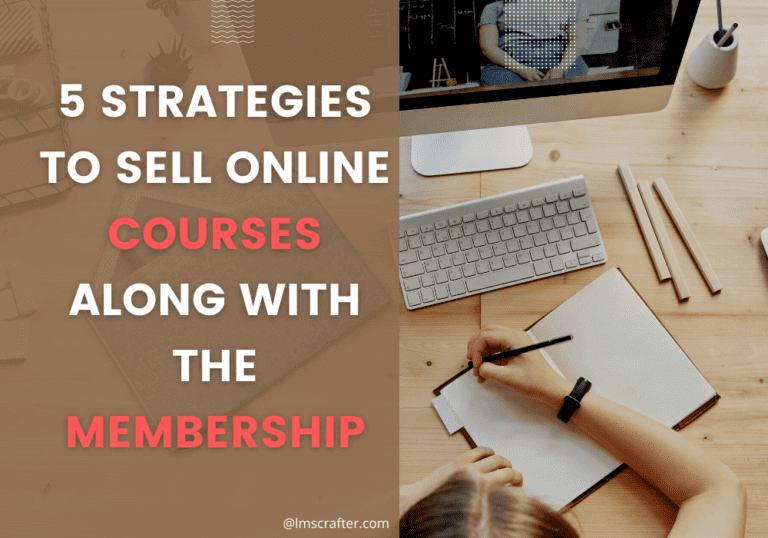Membership or Online course? Which is the Better Option in 2024?

Online learning is no longer a superficial thing. With the advent of Covid-19, many businesses are shifting to purely digital models. In a recent study by Meticulous Research, the LMS market is expected to grow to $28.1 billion by 2025, growing at a CAGR of 20.5% from 2019. However, when starting an online learning website, one of the main questions that arise from the brink of the mind is: Should you go for creating online courses or a full-on membership site?
So, let’s have a look at what’s the difference between them, and then we will be discussing the pros and cons of each of them. In the end, you will be getting some tips to choose one.
Let’s begin.
Online Course:

- Online courses usually have a one-time fee for lifetime access to that specific version of the course.
- They have clear ending points and limited content. Once the reader has gone through all over the course step by step, it will have a completion point.
- Online courses are more structured than membership. They have specific modules or lessons. The user needs to go through all of them to reach an ending point. Some courses provide all the content upfront, while some may use the drip-feed method. In this method, the user has to complete one lesson to unlock the next one. Some courses are guided by instructors while some are self-assessed by the users.
Pros of Online Course |
Cons of Online Course |
| These are clearly defined products with specific outcomes. So, it’s easy to market them than memberships which are a “big box” of many things. | An online course is a finished product, which means you can not add anything once it’s published. Therefore, there is more need to do everything in a perfect manner. |
| Once the course is finished, most of the work is done. Now you just have to market it. It is a finished product, you don’t have to include more content in a course. | As most of the work is done before launch, there is more risk involved. If your course does not fit the market, all your precious hours are wasted for nothing. |
| Courses are one-time pay-offs. Once a person has purchased a course, you don’t have to worry to retain him. | An online course does not offer recurring income from a single person. You need to do marketing to attract more people who can buy your course. |
| You can create multiple courses and sell them on a single platform. | It is harder to expand on the topic. You can not offer supporting materials without offering a new whole course. |
| Usually, courses are sold at a higher price while the membership also costs the same but its price is usually divided into smaller payments. By selling courses, you can get a handsome amount of immediate cash. | Membership’s initial payment seems a bit cheaper than the course and it offers multiple resources, so people perceive courses as a bit expensive. |
Membership Website:

- In a membership, site access is tied to payment. Each membership site has its own cycle of monthly, quarterly or yearly subscriptions. Once the person cancels a subscription and stops paying further, the access to membership is denied. If he keeps on paying, the membership continues indefinitely.
- Membership has no set endpoint. You have to upload new content or upgrade existing content regularly. They have not frozen pieces of information with a set finished product. Successful memberships are filled with the latest content in their specific niche to retain existing members and attract new ones.
- Another very important aspect of membership is its community. Usually, membership platforms build communities around the central topic or idea. They have discussion boards or forums where members can interact with each other and share their ideas.
Pros |
Cons |
| Membership is not a finished product. It requires new content continuously. So, it’s easy to evolve and change over time. | Memberships require a long-term commitment. It requires adding more content and a long time to build a community and evolve over time. |
| Membership provides recurring revenue and a low churn rate from the users. | It is important to retain users to get recurring revenue. Once a user cancels a subscription, one money stream is down. |
| As talked about before, generally memberships are sold at a relatively lower price than a course. Often users are paying the same as a high-priced course, but the cost is broken in multiple offerings and initial payment is usually low which makes it more accessible. | As the initial price is low, you have to wait to reach a certain financial milestone. With courses, it’s comparatively faster if your launch is successful. |
| Successful membership does not only rely on content but also on the community. If you are successful at building a good, resourceful, and assisting community, people are more likely to stay. | You are the leader of your membership community. You need to have good socialization skills to communicate with people and retain them in your membership community. |
Online Course or Membership: Which one to choose?

Here is a checklist to choose either an online course or membership.
1. Topic:
It is probably one of the most important things to consider. What is the topic on which you want to build your LMS(Learning Management System). Is your topic expandable? Are you working on a topic that is evolving over time and offers new material with each passing day? If yes then you should go for membership.
Does your topic offer certain results and a structured way or steps to get those results? Is it something that people want to learn quickly without fussing about any additional support from the seller? If yes then you should go for an online course.
2. Commitment:
If you want quicker results without worrying about long-term commitment, then an online course is the better option. If your concern is long-term recurring income and you are committed to building and expanding on your passion, then membership is a go-go.
3. Online Community:
An online community is more important for a successful membership site than online courses. If you want to make a hub for like-minded people where they can interact and share their views, ideas, and problems and you are the moderator, then it is a good thing for a membership. You should also have a good knowledge of your audience and offer your services according to their requirements.
4. Churn Rate:
Churn rate is the rate at which customers stop doing business with a company over a given period of time. If you want your churn rate low you can opt for a subscription method which usually includes recurring income but its initial cash flow is a bit low. If you want your initial cash flow higher then you should opt for the course method but it has a higher churn rate because once the buyer has purchased the course the business is done.
Still confused? Do you know you can also sell a combination of Membership and Online courses? Check out our blog for more information. Happy learning…
P.S: Either way, you decide to go, you’ll need the right tools to help you get there. We offer the perfect solution for WordPress site owners that decide to run an LMS site. Check out our services page for further information.







